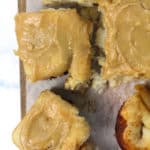The BEST Cinnamon Rolls
The BEST Cinnamon Rolls bring back all the memories of childhood. The dough is unbelievably soft, and the sugar and cinnamon mixture takes them to the next level! Treat your family to a batch of these soon!
Servings 24 rolls
Calories 301kcal
Ingredients
For the dough:
- 2 Tablespoons yeast - I use Red Star
- 1/3 cup sugar
- 2 cups warm water - not hot, not cold
- 1/3 cup canola oil
- 2 teaspoons salt
- 3 Tablespoons powdered milk
- 5-6 cups all-purpose flour - or to right of consistency
For the sugar and cinnamon mixture:
- 6 Tablespoons unsalted butter slightly softened
- 1 cup brown sugar
- 3 Tablespoons cinnamon - more or less, depending on your preference
For the caramel frosting:
- 6 Tablespoons unsalted butter
- 1 cup brown sugar
- 1/4 cup milk
- 2 cups powdered sugar
Instructions
For the dough:
- In a large standing mixer, combine yeast, sugar, and warm water. Be careful to use WARM water, not hot. If the water is too hot, the yeast will disappear and you can't make bread without yeast. Mix and let sit for about 15 minutes to get the yeast working. You should see little bubbles in the water.
- Add the oil, salt, and powdered milk. Stir with a spatula. Attach dough hook to mixer and add about half of the flour. Start the mixer and let the flour absorb.
- Gradually add more flour, a little bit at a time until the dough is less sticky and pulls away from the sides of the mixer. You want the bread dough to be slightly sticky, but not too much. When you touch the dough, it should bounce back slightly. Be sure to leave the mixer on for several minutes after you get the right consistency.
- Grease a large bowl with canola oil. Add dough to the bowl, making sure you smooth it into a ball, by punching it down - starting in the center of the dough. Place dough with smooth side up and cover with a clean towel. Let the dough double (approximately) in size.
- Once doubled, punch down the dough again - by pushing down with your fists in the middle of the dough, pulling the outer edges in towards the middle. Re-grease the bowl with oil and place the dough with smooth side up. Let rise until doubled in size again.
Adding the sugar and cinnamon mixture:
- Take about 1/3 of the dough, and press it on a well-greased surface, into a rectangle. (See pictures above.) Using your hands, spread two tablespoons of butter on the dough. Then sprinkle 1/3 cup of brown sugar and one tablespoons of cinnamon all over the dough.
- Gently roll the dough up into a long log. (See pictures above.) Using a serrated edge knife, cut dough log into about 1.5 inch sections. Place sections into greased pans, and press down slightly, so that the cinnamon sugar is visible on top.
- Continue with the other 2/3 of the dough. This recipe should make about three pans of rolls, depending on how big you make them.
- Cover the pans with a clean dishtowel, and let rise again until dough is almost doubled. This dough rises fast in Texas, and only takes about 20-30 minutes to be ready to bake.
- Bake rolls in 350 oven, for about 22 minutes, or until rolls are nice and golden on the top, and slightly golden on the bottom. Remove rolls to cooling racks.
For the caramel frosting:
- In a small saucepan over medium heat, melt the butter and then add the brown sugar. Mix well and cook for a couple of minutes, stirring constantly. Add the milk and bring to a boil. Remove from heat and add the powdered sugar. Mix very well and set aside.
- It may take 15 - 20 minutes for the frosting to set up. You want it to have a thick but spreadable consistency. If it becomes too thick, add a few more drops of milk and stir. Or you can heat it up in the microwave slightly before spreading.
Video
Notes
- When you add the warm water to the yeast and sugar – be careful to use WARM water, not hot. If the water is too hot, the yeast will disappear and you can’t make bread without yeast. Also, do not use cool water because it won’t activate the yeast.
- Don’t add all the flour at once because every baking day is different. Some days you will need a bit more flour and some days, you will need less.
- The powdered milk is a must. I've tried it with regular milk, but the powdered milk seems to make the softest dough.
- The dough should be slightly sticky when ready, as opposed to bread recipes. Over time, you will learn exactly how much flour is needed to make the ultimate rolls.
- When done, the bottom of the rolls should be slightly brown, and the top, a nice golden brown.
- I like to frost these with caramel frosting (shown below). But you could also use a cream cheese frosting or even a simple glaze.
- These rolls freeze well, unfrosted, using freezer bags.
Nutrition
Calories: 301kcal | Carbohydrates: 52g | Protein: 3g | Fat: 9g | Saturated Fat: 4g | Cholesterol: 16mg | Sodium: 205mg | Potassium: 76mg | Fiber: 1g | Sugar: 31g | Vitamin A: 191IU | Vitamin C: 1mg | Calcium: 42mg | Iron: 1mg
